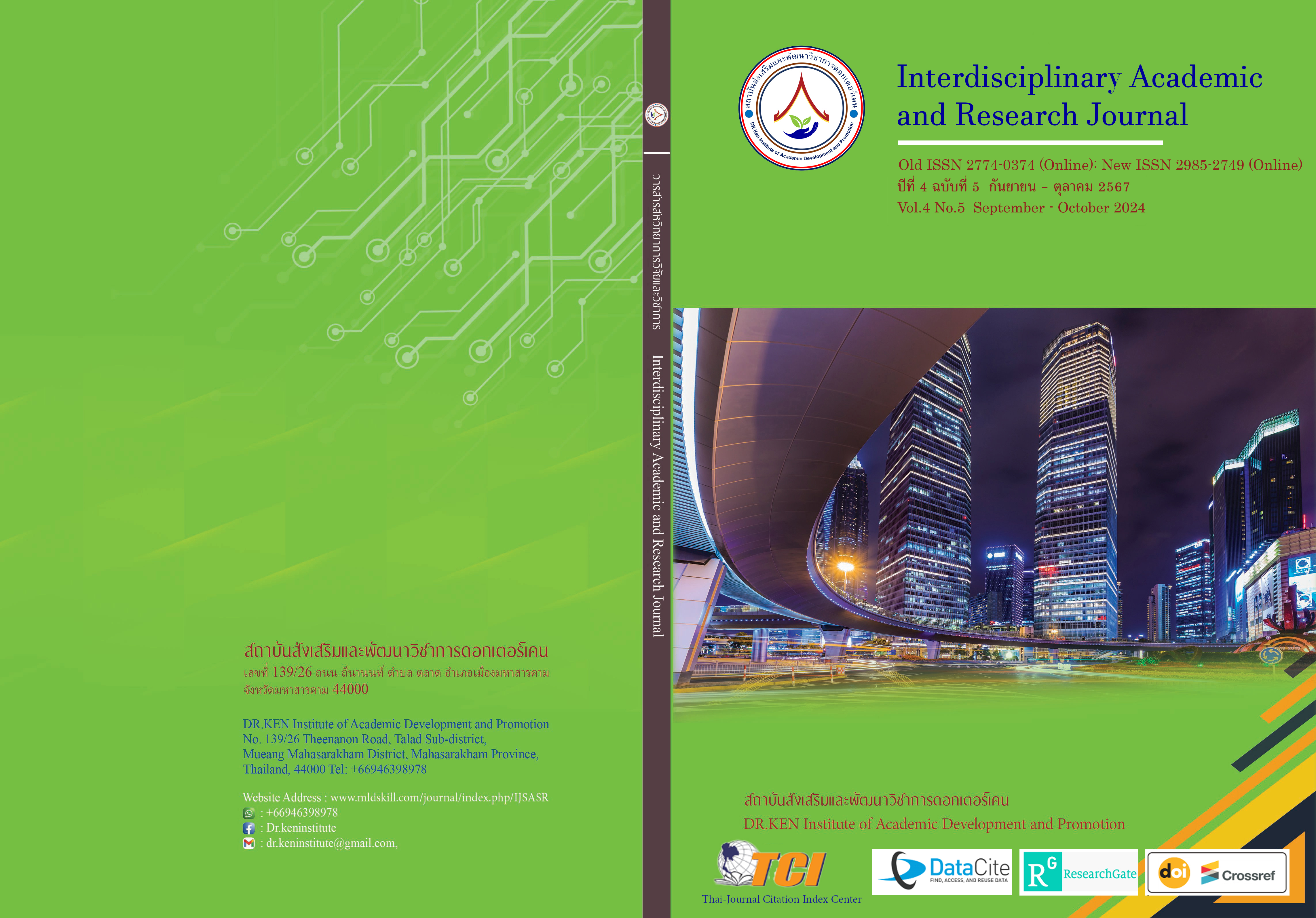Digital Leadership of School Administrators under the Jurisdiction of the Sakon Nakhon Secondary Educational Service Area Office
DOI:
https://doi.org/10.60027/iarj.2024.276119Keywords:
Leadership in Digital Age; , Educational Institution Administrators; , Learning Management SupportAbstract
Background and Aims: The world changes in the 21st century to a fully digital era. As a result, school management must inevitably use technology as a tool to support teaching and learning. Schools in this century have undergone significant changes in many areas, such as the nature of knowledge. Learner's role and the role of the teacher. This is something that school administrators need to have the ability to understand and to support these changes. This research has the following objectives: 1) to study the digital leadership level of educational institution administrators under the Sakon Nakhon Secondary Educational Service Area Office. 2) To compare the digital leadership of educational institution administrators under the Sakon Nakhon Secondary Educational Service Area Office. Classified by position Work experience and the size of the educational institution. 3) To study methods for developing digital leadership of educational institution administrators under the Sakon Nakhon Secondary Educational Service Area Office.
Methodology: The sample used in this research consisted of 331 school administrators and teachers. The sample size was determined according to Krejci and Morgan's table. and used the random sampling method. The research instrument was a questionnaire with a 5-level rating scale. Which has a consistency index value in the range of 0.80 - 1.00 and a reliability value for all questionnaires equal to 0.86. Statistics used in data analysis include frequency, percentage, mean, standard deviation, T-value and F-value tests.
Results: The results of the research found that: (1) A study of the level of leadership in the digital age of administrators of educational institutions under the Sakon Nakhon Secondary Educational Service Area Office. Overall and in each aspect are at a high level. (2) Results of comparing opinions about leadership in the digital age of administrators of educational institutions under the Sakon Nakhon Secondary Educational Service Area Office. Classified by position Work experience and the size of the educational institution Overall and in each aspect, no differences were found. (3) Guidelines for promoting and developing leadership in the digital age of administrators of educational institutions under the Sakon Nakhon Secondary Educational Service Area Office consist of 5 areas: 1) having a modern leadership vision, 2) developing creativity, 3) paying attention to the needs of teachers and students, 4) increasing the efficiency of working together, and 5) promoting to have knowledge and ability.
Conclusion: The study found that educational administrators in Sakon Nakhon demonstrate strong leadership in the digital age across all areas, with no significant differences based on position, experience, or institution size. It also emphasizes five key strategies for improving leadership: cultivating a modern vision, creativity, attention to stakeholder needs, collaboration, and ongoing skill development.
References
กวินท์ บินสะอาด. (2564). ภาวะผู้นำยุคดิจิทัลของผู้บริหารสถานศึกษา สังกัดสำนักงานเขตพื้นที่การศึกษา ประถมศึกษาสตูล. วิทยานิพนธ์. สงขลา: มหาวิทยาลัยหาดใหญ่.
จิณณวัตร ปะโคทัง. (2561). ภาวะผู้นำยุคดิจิทัลสำหรับผู้บริหารสถานศึกษามืออาชีพ. มหาวิทยาลัยราชภัฏอุบลราชธานี.
จีระศักดิ์ ชุมภู. (2564). การศึกษาภาวะผู้นำเชิงเทคโนโลยีของผู้บริหารโรงเรียน ในกลุ่มสหวิทยาเขตสุดถิ่นไทย จังหวัดเชียงราย. ปริญญาการศึกษามหาบัณฑิต สาขาวิชาการบริหารการศึกษา, มหาวิทยาลัยพะเยา.
ดาวรุวรรณ ถวิลการ. (2564). ภาวะผู้นำดิจิทัล Digital Leadership. ขอนแก่น: มหาวิทยาลัยขอนแก่น.
ทศพล สุวรรณราช. (2564). ภาวะผู้นำดิจิทัลของผู้บริหารสถานศึกษา สังกัดสำนักงานเขตพื้นที่การศึกษามัธยมศึกษานนทบุรี. วารสารมนุษยศาสตร์และสังคมศาสตร์ มหาวิทยาลัยราชพฤกษ์, 7(3), 160-161.
ทินกร บัวชู. (2562). ภาวะผู้นำดิจิทัลของผู้บริหารสถานศึกษา. ครุศาสตร์สาร, 13(2), 285-294.
นิกร จันภิลม และศตพล กัลยา. (2562). เทคโนโลยีการศึกษาในยุค Thailand 4.0. วารสารปัญญาภิวัฒน์, 11(21), 304-314.
บุญชม ศรีสะอาด. (2545). การวิจัยเบื้องต้น. พิมพ์ครั้งที่ 7. กรุงเทพฯ: สุวีริยาสาส์น.
บุญชม ศรีสะอาด. (2553). การวิจัยเบื้องต้น. พิมพ์ครั้งที่ 8. กรุงเทพฯ : สุวีริยาสาส์น.
พิชญ์พิมล สุนทะวงศ์. (2565). แนวทางการพัฒนาภาวะผู้นำเชิงดิจิทัลของครู สังกัดสำนักงานเขต พื้นที่การศึกษามัธยมศึกษามหาสารคาม. วิทยานิพนธ์. มหาสารคาม: มหาวิทยาลัยมหาสารคาม.
ภูรีรัตน์ สุกใส. (2565). ความสัมพันธ์ระหว่างภาวะผู้นำดิจิทัลของผู้บริหารสถานศึกษา กับความเป็นองค์กรแห่งนวัตกรรมของสถานศึกษาระดับมัธยมศึกษาในจังหวัดอุตรดิตถ์. การค้นคว้าอิสระ. พิษณุโลก: มหาวิทยาลัยนเรศวร.
รุจาภรณ์ ลักษณะดี. (2565). ภาวะผู้นำการดิจิทัลของผู้บริหารสถานศึกษาในสหวิทยาเขตบ้านบึง 1 สังกัดสำนักงานเขตพื้นที่การศึกษาประถมศึกษาชลบุรี เขต 1. วิทยานิพนธ์. กรุงเทพมหานคร: มหาวิทยาลัยเกริก.
วรวุฒิ เพ็งพันธ์ (2561). การศึกษาไทย 4.0 กับการพัฒนาระเบียงเศรษฐกิจพิเศษภาคตะวันออก. วารสารศึกษาศาสตร์, 29(3), 3-4.
อภิชาติ ครองยศ. (2560). ความสัมพันธ์ระหว่างภาวะผู้นำกับแรงจูงใจในการปฏิบัติงานของข้าราชการตำรวจสายงานจราจร สถานีตำรวจภูธรเมืองสกลนคร. วารสารบัณฑิตศึกษา, 15(71), 73-79.
Rothidsathan, B. (2016). Policy of Higher Education. Retrieved July 20, 2018, from http://www.moe. go.th/websm/2016/sep/385.ht2.jpg
Zhu. (2016). Five Key Elements in Digital Leadership. Retrieved from: http://futureofcio.blogspot.com/2015/01/five-key-elements-in-digitalleadership.html.
Downloads
Published
How to Cite
Issue
Section
License
Copyright (c) 2024 Interdisciplinary Academic and Research Journal

This work is licensed under a Creative Commons Attribution-NonCommercial-NoDerivatives 4.0 International License.
Copyright on any article in the Interdisciplinary Academic and Research Journal is retained by the author(s) under the under the Creative Commons Attribution-NonCommercial-NoDerivatives 4.0 International License. Permission to use text, content, images, etc. of publication. Any user to read, download, copy, distribute, print, search, or link to the full texts of articles, crawl them for indexing, pass them as data to software, or use them for any other lawful purpose. But do not use it for commercial use or with the intent to benefit any business.
















.png)


